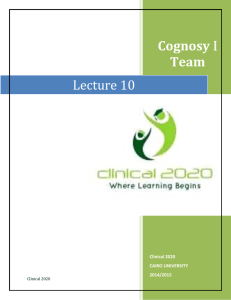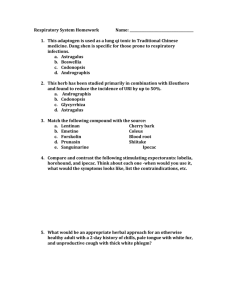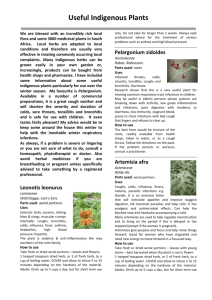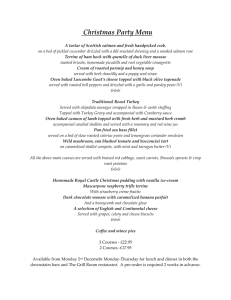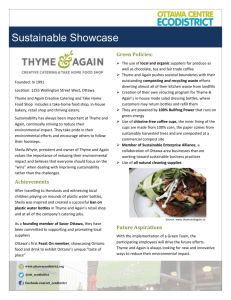Quality of thyme herb (Thymus vulgaris L.) from organic cultivation.
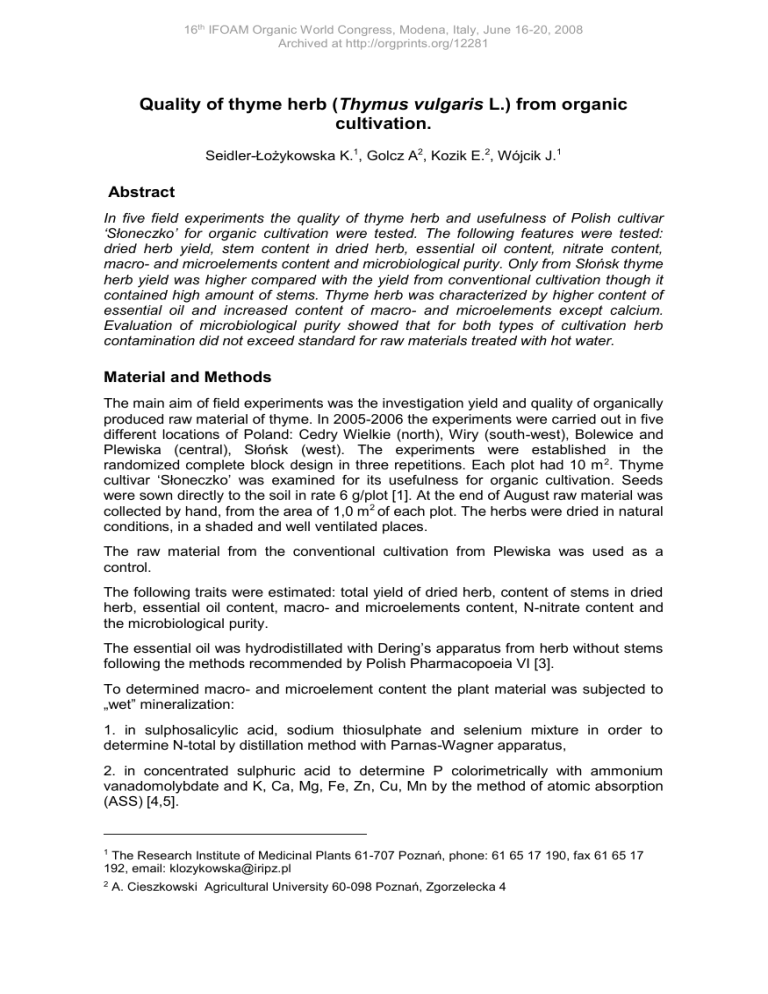
16 th IFOAM Organic World Congress, Modena, Italy, June 16-20, 2008
Archived at http://orgprints.org/12281
Quality of thyme herb (Thymus vulgaris L.) from organic cultivation.
SeidlerŁożykowska K.
1 , Golcz A 2 , Kozik E.
2 , Wójcik J.
1
Abstract
In five field experiments the quality of thyme herb and usefulness of Polish cultivar
‘Słoneczko’ for organic cultivation were tested. The following features were tested: dried herb yield, stem content in dried herb, essential oil content, nitrate content, macro- and mic roelements content and microbiological purity. Only from Słońsk thyme herb yield was higher compared with the yield from conventional cultivation though it contained high amount of stems. Thyme herb was characterized by higher content of essential oil and increased content of macro- and microelements except calcium.
Evaluation of microbiological purity showed that for both types of cultivation herb contamination did not exceed standard for raw materials treated with hot water.
Material and Methods
The main aim of field experiments was the investigation yield and quality of organically produced raw material of thyme. In 2005-2006 the experiments were carried out in five different locations of Poland: Cedry Wielkie (north), Wiry (south-west), Bolewice and
Ple wiska (central), Słońsk (west). The experiments were established in the randomized complete block design in three repetitions. Each plot had 10 m
2
. Thyme cultivar ‘Słoneczko’ was examined for its usefulness for organic cultivation. Seeds were sown directly to the soil in rate 6 g/plot [1]. At the end of August raw material was collected by hand, from the area of 1,0 m 2 of each plot. The herbs were dried in natural conditions, in a shaded and well ventilated places.
The raw material from the conventional cultivation from Plewiska was used as a control.
The following traits were estimated: total yield of dried herb, content of stems in dried herb, essential oil content, macro- and microelements content, N-nitrate content and the microbiological purity.
The essential oil was hydrodistillated with Dering’s apparatus from herb without stems following the methods recommended by Polish Pharmacopoeia VI [3].
To determined macro- and microelement content the plant material was subjected to
„wet” mineralization:
1. in sulphosalicylic acid, sodium thiosulphate and selenium mixture in order to determine N-total by distillation method with Parnas-Wagner apparatus,
2. in concentrated sulphuric acid to determine P colorimetrically with ammonium vanadomolybdate and K, Ca, Mg, Fe, Zn, Cu, Mn by the method of atomic absorption
(ASS) [4,5].
1 The Research Institute of Medicinal Plants 61707 Poznań, phone: 61 65 17 190, fax 61 65 17
192, email: klozykowska@iripz.pl
2 A. Cieszkowski Agricultural University 60098 Poznań, Zgorzelecka 4
16 th IFOAM Organic World Congress, Modena, Italy, June 16-20, 2008
Archived at http://orgprints.org/12281
N-nitrate content in dried herb was determined by Bremner distillation method in modification done by Starck after extraction in 2 % acetic acid [5].
In Microbiology Laboratory the evaluation of raw material microbiological purity was carried out following Polish Pharmacopoeia VI standards for raw materials treated with hot water (gr. III e) [3]. Number of aerobic bacteria, number of yeasts and moulds and number of Escherichia coli were estimated in dried herb. Additionally the number of intestine bacteria from family Enterobacteriaceae was evaluated. Investigations were done after 6 and 12 months of storage in darkness and room temperature.
The obtained data were evaluated by analysis of variance. The mean values were compared by the use of Students’ t test with the confidence level of 5%.
Results and Discussion
The yield of dried thyme herb varied from 120,1 (Cedry) to 1150,0 g/m 2 (Słońsk) and was significantly different (table 1). Stem content in thyme herbs was also significantly different and oscillated from 34 (Wiry) to 49 % (Słońsk). The yield of herb from Słońsk contained a lot of stems and was higher than that from conventional cultivation.
Following the breeder’s characteristic of thyme cultivar ‘Słoneczko’ stem content should not be higher than 34 % (SeidlerŁożykowska. & Kazmierczak 2001).
Tab. 1: Thyme herb yield [g/m
2
], stem content [%], essential oil [%] and N-nitrate content [mg/kg d.m.] locality Dried herb Stem
Bolewice 155,2 ab 39 a
Essential oil content
2,20 b
N-N0
3 content
250,0
Cedry W.
Plewiska
Słońsk
Wiry
Cont. Plewiska
LSD
0,05
120,1 ab
293,9 b
1150,0 c
162,2 ab
437,8 b
203,07
39 a
38 a
49 b
34 a
38 a
7,77
1,93 a
2,35 b
2,18 b
2,37 b
2,00 a
0,222 trace trace
118,5 trace
425,0
-
Essential oil content ranged from 1,93 (Cedry W.) to 2,37 % (Wiry) and was high in all the experiments; these results exceeded the one given by Dachler and Peltzman
(1999) ranging between 0,5 and 1,5 %.
The content of N-nitrate in dried herb oscillated from traces (Cedry, Plewiska, Wiry) to
425,0 mg/kg d.m. (control) and varied according to its origin. Different results were obtained by, who analyzed nitrate content in medicinal plant raw materials of different origin. In her experiment the range of nitrate content oscillated from 207,9 (St John’s
16 th IFOAM Organic World Congress, Modena, Italy, June 16-20, 2008
Archived at http://orgprints.org/12281
Mn
Cu
Zn
P
K
Ca
Mg
Fe wort herb) to 16 921,0 mg KNO
3
/kg d.m. (nettle herb). Ours and the cited study of
Leszczyńska (1999) showed that although spices are used in small amounts in daily diet, the nitrate content should be regarded while day allowance intake (ADI) is calculated. The mean content of nitrogen, phosphorus, potassium, magnesium and microelements (Fe, Mn, Cu, Zn) was higher in the organic thyme herb compared to conventional one, except the content of calcium (table 2).
Tab. 2: Macro- [%] and microelements [ppm] content in thyme herb element Organic cultivation Conventional cultivation
Plewiska range mean
N 1,89 - 2,70 2,28 2,12
0,22 - 0,40
2,07 – 2,50
1,09 – 1,89
0,31 – 0,51
251,2 - 725,2
0,30
2,35
1,42
0,39
552,0
0,35
2,07
1,54
0,27
404,10
25,9 – 334,5
12,3 – 18,2
56,9 – 116,8
146,6
15,2
87,3
54,90
8,10
65,10
In organic herb the content of Fe, Mn and Cu was higher, while in conventional herb
Fe and Cu content was lower compared with the results obtained by Marsh et al. [9].
According to Kabata-Pendias and Pendias (1999) in Polish climatic conditions Cu content ranged from 5
– 20 mg kg -1
(Kabata-Pendias & Pendias 1999). The levels of
Cu content in herbs obtained from both types of cultivation could be placed in the ranges set also by SuchorskaOrłowska et al. 2006. The results of microbiological analysis showed a great diversification of microbiological contamination of thyme herb depending on its origin (table 4). The most contaminated herb was from Słońsk and the lowest
– from Bolewice. Though, all of the investigated herbs were below the level of standard contamination. Soil and organic fertilization are the main sources of microbiological contamination of raw material. After 12 months of storage the microbiological contamination of storage herb was diminished in the different rates.
According to Kędzia (1999) there are two main reasons of this process: 1. bacteria have different susceptibility for dryness and 2. plant active substances (essential oil, anthocyanins and tannins) have strong effect on raw material microbes. Although
Escherichia coli content was very low in all tested trials, the contamination of raw material organically produced should be controlled, following the fact that manure is a basic type of fertilization there.
16 th IFOAM Organic World Congress, Modena, Italy, June 16-20, 2008
Archived at http://orgprints.org/12281
Tab. 3: Microbiological purity of thyme after 6 and 12 months of storage locality Aerobic bacteria in 1g
Yeasts and moulds in
1g
Enterobacteriaceae in 1g
Escherichia
coli in 1g
6 m 12 m 6 m 12m
Bolewice 41. 500 29.000 20 10
6 m
4.000
12m
100
6 m
<10
12m
<10
Cedry W.
Plewiska 485.000 34.000 125 40
Słońsk
Wiry
430.000 32.000
780.000 32.500 7.400
240.000 27.500
420
245
10
140
10
Control
Plewiska
357.500 45.000 130 20
Standard 10.000.000 100.000
41.000
4.000
91.500
7.500
1.200
-
100
850
500
240
70
<10 <10
<10 <10
<10 <10
<10 <10
<10 <10
100
Conclusions
Thyme herb yield only from Słońsk was higher compared with the yield from conventional cultivation. The quality of thyme herb from organic cultivation (essential oil, macro- and microelements content, microbiological purity) was high but not higher than the one from conventional cultivation. Thyme cultivar ‘Słoneczko’ is suitable for both organic and conventional cultivations.
References
Kabata-Pendias A. Pendias H. (1999): Biochemistry of microelements. PWN Warszawa, 398p.
Kędzia B. (1999): Badania nad zanieczyszczeniem surowców zielarskich drobnoustrojami.
Habilitation Thesis, Research Institute of Medicinal Plants, Poland.
Leszczyńska T. (1994): Nitrate and nitrite in spice. Bromat Chem Toksykol. 27(4):323-325p.
Nowosielski O. (1988): Zasady opra cowywania zaleceń nawozowych. 3rd ed. PIWRiL Warszawa,
212-214p, 291-298p.
SeidlerŁożykowska K. & Kazmierczak K. (2001): Hodowla roślin przyprawowych w IRiPZ. Annales
Universitatis Mariae CurieSkłodowska 9:307-310p.
SuchorskaOrłowska J. Jadczak D. Brzostowska-Żelechowska D. (2006): Zawartość niektórych mikroelementów w wybranych gatunkach ziół. Fol. Hortic. Suppl.2:174-180p.
